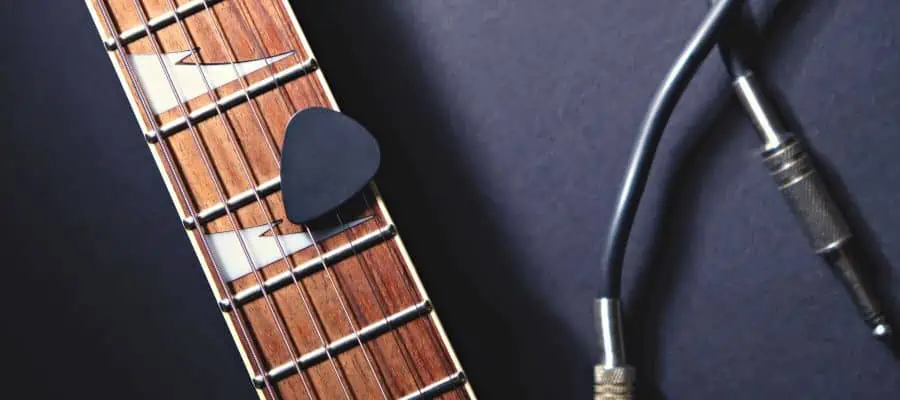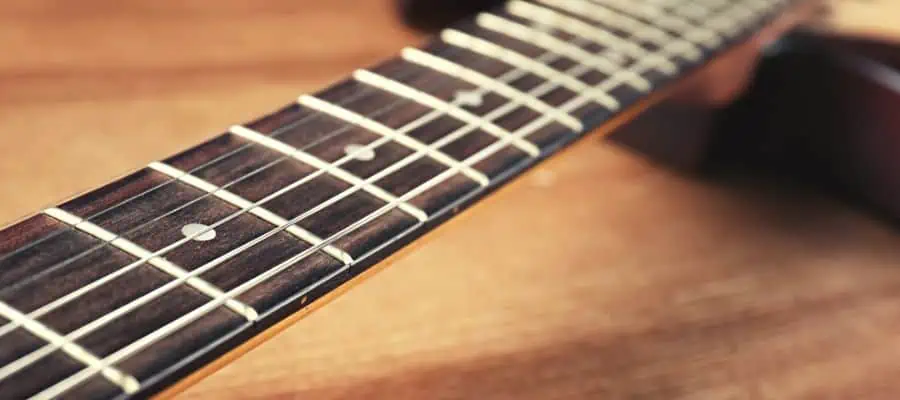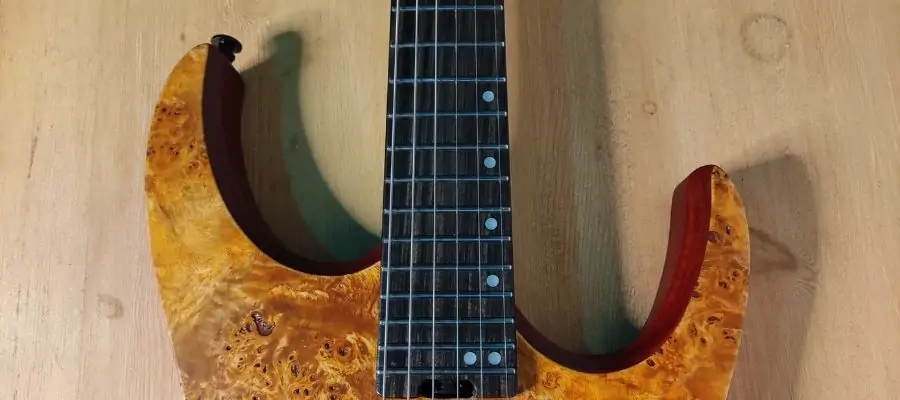Have you noticed that the frets on your guitar get narrower the higher they are on the neck? You may be wondering about the reason behind it. The answer has to do with the vibration and pitch, the mechanics of the sound production from strings.
The higher a fret is located on the fretboard, the shorter the gap is between the two frets. This has a simple mathematical explanation behind it. Each semitone, meaning each fret on the guitar, has to be 1/18 fraction of the total string length. This way, the notes can match the frequencies they vibrate in.
Following this equation, if you take a guitar with a 25.5” scale length, the gap between the nut and the first fret will be around 1.42”, while the gap between the first and the second fret will be 1.33” as the string length gets shorter. This way, each gap between frets gets shorter and shorter.
In this article, you’ll learn more about why guitar frets get smaller the higher they are on the guitar. Plus, I included information on how the strings produce sound to help you better understand the frets’ placements.
Why The Gap Between Guitar Frets Get Smaller

The gap between guitar frets gets smaller due to how the instrument produces sound. Shorter strings make a higher note, while longer strings have a lower pitch. So, fretting a string changes the sound compared to playing an open string. The frets show you where to put your fingers to play correct notes.
The fretting placements create different pitches, allowing you to play all the notes on the scale with your guitar. However, the frets become narrower to maintain an increasing half-step in pitch between the notes.
Each time you move down one fret, the pitch increases by one semitone. For example, the pitch difference between an F and an F# or E and F is a semitone.
Every semitone is actually a fraction of the string length. The ratio is roughly 1/18. So, let’s say you have a 20” string length. Your first fret will be 1.11” wide, as that is the number you get when you divide 20 by 18.
For the second fret, we calculate the string length by subtracting 1.11”, which is the first fret width, from our total string length of 20”. We get the 18.89”, our total string length for the 2nd fret. When we divide 18.89” by 18, we get our 2nd fret width, which is 1.05”.
As you see, for the changes in pitch to remain consistent, the frets must get closer together the higher they go.
What if the Frets Didn’t Shrink?
So, what would happen if the guitar frets didn’t shrink? Well, if they were a consistent distance throughout, your guitar would be out of tune. It wouldn’t sound good at all.
The spacing of the frets provides you with half-step increments in pitch. However, the steps between the pitches would be random if you had the same distance between all frets on the board. It would be hard, if possible, to play in tune by putting your fingers on the frets.
So, the frets must be placed correctly for the guitar to sound good. If they don’t get closer, the frequency difference between each fret would be more than a semitone, even going over a full tone after a certain point.
Do All Guitars Have the Same Distance Between Frets?

Guitars don’t have the same distance between frets because the guitar and the scale sizes vary. They may have different scale lengths, impacting where the frets are located. However, the distance between frets should shrink at the same rate.
The frets should all shrink at a similar rate or percentage, not a fixed number. So, while they may not have the exact distance between their frets, they’re still in tune with other guitars. Generally, there’s a 5.5% difference in string length between semitones.
If all guitars had the exact distance between frets, they would be horribly out of tune and unplayable for the same reasons in the section above. The frets need to shrink at a consistent rate for the guitar to sound good.
But that doesn’t mean they’ll always have the same distance between frets as another guitar due to differences in size and shape. Some guitars can have very long or short neck boards, which can drastically impact the fret placement.
For example, Fender Stratocasters generally have a 25.5” scale length. So, the 1st fret is 1.45” wide, while the 2nd fret is 1.33” wide. However, Gibson Les Pauls often has a shorter scale length, which is around 24.75”. So, the Les Paul’s 1st fret is 1.375” wide, while the 2nd fret is 1.299” wide. As you see, the measurements are different, but the ratio of the frets getting narrower is the same, which is 5.5%.
The Rule of 18

If you want to calculate guitar fret positions, you can use the Rule of 18. To determine where the frets go, divide the scale length (the distance between the guitar’s nut and bridge) by 18. This will be where the first fret goes.
To determine where the next fret goes, divide the scale length minus the distance between the nut and that fret by 18. You keep doing this the whole way down the neck of the guitar until all of the frets are in the correct positions.
(Scale Length – The Distance Between The Nut And The Chosen Fret) / 18 = The Chosen Fret Width
Technically, if you want the frets to be in the best positions possible, you’d use 17.817 to divide the string length. While 18 is a reasonable estimate, 17.817 is much better for accuracy, but the “Rule of 18” is easier for people to remember. If you’re not handmaking a guitar, it’s close enough.
Using these calculations, the 12th fret will be halfway between the length of the scale. Since the 12th fret should be exactly one octave higher than an open string, the 12th fret must rest precisely in the middle of the string. On average, a majority of guitars have between 19 and 24 frets, so they’ll need to be spread out at an even rate for the rest to fit.
The Rule of 18 might only sound helpful if you plan to make guitars at first. However, it still offers insight into how the frets impact the sound of your string and why they are where they are. You can also use this information to help you decide where to clamp a capo on your guitar to change the pitch.
This YouTube video explains the Rule of 18 and how the string length impacts the sound of your guitar in more detail:

Do Guitar Frets Wear Out?
Guitar frets can wear out after a lot of use. It’s normal for them to have some gaps on them, but if you let them go for too long, the wear and tear can change the tone of your guitar.
You’ll hear a buzzing sound, and the note will be out of tune. If it’s bad enough, the string won’t even make a sound when you pluck it on that fret.
So, guitar frets can wear out. However, it won’t happen for a very long time unless you play your guitar every day for hours.
You can check my article if you want to know more about fret wear and maintenance.
Final Thoughts
To summarize, guitar frets get smaller the further they are on the neckboard. The fret placements must be calculated and exact for the instrument to be in tune since each fret is about a half-step between notes. If the placements aren’t correct, the guitar will sound off.
Overall, guitar makers need to keep fret placement in mind when crafting. Now you know why!
If you found this article useful, you may want to save this pin below to your Guitar board.

Recent Posts
When learning new songs have you noticed that some of the chord sequences sound really good? But when you tried to come up with your own chord sequence, or as we call it chord progression, you found...
Some guitarists insist on buying an expensive amplifier with their electric guitar. They assume that this is a must for every type of guitarist out there. However, in some situations, this isn’t...

